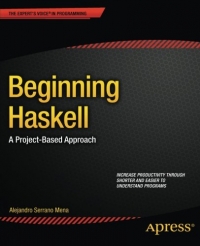
Beginning Haskell
Book Description
Beginning Haskell provides a broad-based introduction to the Haskell language, its libraries and environment, and to the functional programming paradigm that is fast growing in importance in the software industry. The book takes a project-based approach to learning the language that is unified around the building of a web-based storefront. Excellent coverage is given to the Haskell ecosystem and supporting tools. These include the Cabal build tool for managing projects and modules, the HUnit and QuickCheck tools for software testing, the Scotty framework for developing web applications, Persistent and Esqueleto for database access, and also parallel and distributed programming libraries.
Book Details
- Publisher: Apress
- By: Alejandro Serrano Mena
- ISBN: 978-1-4302-6250-3
- Year: 2014
- Pages: 428
- Language: English
- File size: 5.1 MB
- File format: PDF
- Download: To Be Uploaded




 雷达卡
雷达卡






 京公网安备 11010802022788号
京公网安备 11010802022788号







